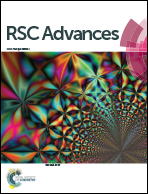Porphyrin-based electrostatically self-assembled multilayers as fluorescent probes for mercury(ii) ions: a study of the adsorption kinetics of metal ions on ultrathin films for sensing applications†
Abstract
The electrostatic multilayer self-assembly technique was employed to prepare fluorescent probes for mercury(II) ions. Films showing an appreciable fluorescence emission were obtained by alternate adsorption of 5,10,15,20-tetrakis(4-sulfonatophenyl)porphyrin (TPPS) with polyelectrolytes. Fluorescence intensity quenching, arising from the coordinative interaction between the porphyrin and mercury ions, was monitored as a function of time. The response mechanism was studied on the basis of kinetic and equilibrium models for adsorption. The adsorption process of mercury ions on porphyrin-based films was described by the pseudo-second-order equation and the kinetic parameters were correlated with the initial concentrations of the metal ions in aqueous solution. The kinetic approach was evaluated as an alternative to monitoring the sensing responses at equilibrium.


 Please wait while we load your content...
Please wait while we load your content...